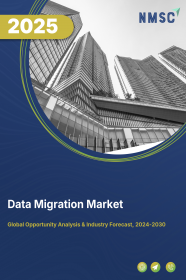
Data Migration Market by Offerings (Software Tools, Services), by Data Source Type (Structured (RDBMS, Spreadsheets), Semi-structured (JSON / XML / Logs), Unstructured (Images, Video, Documents)), by Deployment Model (Cloud‑Hosted (SaaS), On-Premises, Hybrid), by Organization Size (SMEs, Large Enterprises), by Migration Target (Storage Migration, Database Migration, Application Migration, Infrastructure Migration), and Others - Global Opportunity Analysis and Industry Forecast 2022-2030
Market Definition:
The Data Migration Market size was valued at USD 8.20 billion in 2021 and is predicted to reach USD 33.58 billion by 2030 with a CAGR of 18.7% from 2022-2030. Data migration is a process of selecting, preparing, extracting, transforming, and transferring data from one computer storage system to another. It requires the use of data profiling, discovery tools, and data quality capabilities that includes extract, transform & load (ETL), data archival, and data masking technologies in the migration process.
Data migration helps in transferring data from one source to multiple applications such as implementing new applications, change in system, migrating to a cloud-based environment, consolidating, upgrading, and modernization of applications. In addition, data migration eliminates wasteful data further improves the security of valuable data, and reconciles databases for better usage. There are different types of data migration that have different kind of migration processes such as storage migration, cloud migration, and application migration.
Market Dynamics and Trends:
The factors such as increase in adoption of cloud services paired with the rapid use of Internet of Things (IoT) and big data in various industry verticals such as BFSI and telecommunications among others have been driving the growth of the data migration market. Also, rising demand for data migration due to less storage space that results in reducing media costs to ensure full data integrity drives the growth of the market.
Moreover, data migration helps in minimizing day-to-day business challenges by improving data security with secure data transfer and server access is expected to propel the growth of the market. Furthermore, data migration scales up resources to meet the growing demand for business datasets by minimizing disruption in business operations with minimal manual efforts.
However, the risk of data integrity, data corruption, and data quality are the factors that restrain the growth of the market. On the contrary, rapid technological advancements that include artificial intelligence (AI) and big data technologies for the development of data migration software and services are expected to create lucrative opportunities for data migration market players in the future.
Market Segmentations and Scope of the Study:
The data migration market is segmented based on data type, service, business function, component, deployment, organization size, industry vertical, and geography. Based on the type, the market is divided into customer, financial, product, supplier, and compliance. Based on the service, the market is classified into PaaS, IaaS, and SaaS. Based on the business function, the market is categorized into marketing, sales, finance, legal, operations, human resource, and others. Based on the component, the market is segmented into software and services. The services are further segmented into managed services and professional services. The professional services are further sub-segmented into support and maintenance services, and consulting services. Based on the deployment, the market is bifurcated into public, private, and hybrid. Based on the organization size, the market is segmented into small and medium enterprises, and large enterprises. Based on the industry vertical, the market is divided into BFSI, telecommunication & IT, retail & e-commerce, healthcare & life sciences, manufacturing, government, energy & utilities, media & entertainment, and others. The geography breakdown and analysis of each of the aforesaid segments include regions such as North America, Europe, Asia-Pacific, and RoW.
Geographical Analysis:
North America region is expected to hold the lion share of data migration market size and is expected to continue dominating the market during the forecast period, owing to the high usage of data migration for accommodating the changing dynamics such as organizational transformation and changing customer requirements in enterprises.
For instance, in November 2020, Google Cloud launched its new Data Migration Service (DMS) to make it easier for enterprises to move production databases to the cloud. DMS is a serverless tool to migrate MySQL, PostgreSQL, and SQL Server databases to Cloud SQL with a few clicks.
Also, rapidly increasing adoption of e-commerce services by companies such as Amazon, IBM, among others to map out functions, and third-party apps with the adoption of omni channel business models drive the market growth in the region.
For instance, in April 2022, Amazon Web Service (AWS) Snow launched large data migration manager for planning and managing large data migrations from premises to AWS. It enables to plan, track, and manage large data migrations while using multiple Snowball Edge service products.
Moreover, the availability of various cost-effective data management software and services such as Microsoft SQL Server and others boost the growth of the market. For instance, Microsoft SQL Helps in storing and retrieving data as requested by other software applications that run either on the same computer or on another computer across a network are the key factors that drive the demand for data migration market in this region.
On the other hand, Asia-Pacific has also witnessed the penetration of data migration due to increasing data volumes paired with the rising number of data-based firms that collect data and provide insights in terms of customers' preferences in real-time. For instance, Alibaba Cloud, a cloud computing and artificial intelligence company based in China offers Cloud Data Transmission Service (DTS), which helps to migrate data between data stores such as relational databases, NoSQL databases, and data warehouses.
DTS is used to migrate data to Alibaba Cloud or between combinations of cloud and on-premises data systems. In addition, the demand for data storage and data processing systems is growing due to the upsurge in the data-based industries and IT start-ups in the countries such as China and India drive the market growth.
For instance, in September 2019, Syniti unveiled the new cloud edition of SAP Advanced Data Migration by Syniti, at Big Data World Singapore. This product leverages AI to capture knowledge and proactively guide users through their data migration, ensuring faster time to value with 100% data quality. Moreover, increasing adoption of cloud computing and IoT devices that helps in ingesting more types of data and larger amounts of data in less time boosts the market growth in this region.
Competitive Landscape:
The data migration market includes various market players such as Amazon Web Services, Inc., Microsoft Corporation, IBM Corporation, Oracle Corporation, SAP SE, Google LLC, MuleSoft, LLC, Snowflake Inc., Informatica LLC, Cloudera, Inc., QlikTech International AB, Boomi LLC, Fivetran, Inc., Hevo Data, Inc., and Airbyte, Inc. These market players are adopting various joint venture strategies and planning expansion of business across various regions to maintain their dominance in the data migration.
For instance, in June 2025, Amazon Web Services (AWS)Experian completed a large-scale migration from mainframes to AWS, reducing data processing times by 60%, enabling real-time analytics, and deploying over 100 generative AI use cases.
Moreover, in August 2025, Snowflake Inc. lPublished a technical paper detailing Snowpark improvements, enhancing secure, scalable support for AI/ML workloads in the Data Cloud.
Key Benefits:
-
The data migration market report provides the quantitative analysis of the current market and estimations from 2022 to 2030. This analysis assists in identifying the prevailing market opportunities to capitalize on.
-
The study comprises of an extensive analysis of the data migration market trends including the current and future trends for depicting the prevalent investment pockets in the market.
-
The information related to key drivers, restraints, and opportunities, and their impact on the data migration market is provided in the report.
-
The competitive analysis of the market players along with their market share in the data migration market is mentioned.
-
The SWOT analysis and Porter’s Five Forces model are elaborated in the study.
-
The value chain analysis in the market study provides a clear picture of the stakeholders’ roles.
Key Market Segments
By Offerings
-
Software Tools
-
Database & Schema Migration
-
ETL/ELT Platforms
-
Bulk Data Transfer Tools
-
CDC/Realtime Engines
-
-
Services
-
Consulting & Advisory
-
Implementation & Integration
-
Managed Migration Services
-
Post-Migration Support
-
By Data Source Type
-
Structured (RDBMS, Spreadsheets)
-
Semi-structured (JSON / XML / Logs)
-
Unstructured (Images, Video, Documents)
By Deployment Model
-
Cloud‑Hosted (SaaS)
-
On-Premises
-
Hybrid
By Organization Size
-
SMEs
-
Large Enterprises
By Migration Target
-
Storage Migration
-
Database Migration
-
Application Migration
-
Infrastructure Migration
By Migration Mode
-
Online (Real‑Time / Change Data Capture)
-
Offline (Big‑Bang / Batch)
By Industry Vertical
-
Banking, Financial Services & Insurance (BFSI)
-
Healthcare & Life Sciences
-
IT & Telecom
-
Retail & e‑Commerce
-
Manufacturing
-
Government & Public Sector
-
Energy & Utilities
-
Media & Entertainment
-
Others
By Geography
-
North America
-
The U.S.
-
Canada
-
Mexico
-
-
Europe
-
The UK
-
Germany
-
France
-
Italy
-
Spain
-
Denmark
-
Netherlands
-
Finland
-
Sweden
-
Norway
-
Russia
-
Rest of Europe
-
-
Asia-Pacific
-
China
-
Japan
-
India
-
South Korea
-
Australia
-
Indonesia
-
Singapore
-
Taiwan
-
Thailand
-
Rest of Asia-Pacific
-
-
RoW
-
Latin America
-
Middle East
-
Africa
-
Key Players
-
Amazon Web Services, Inc.
-
Microsoft Corporation
-
IBM Corporation
-
Oracle Corporation
-
SAP SE
-
Google LLC
-
MuleSoft, LLC
-
Snowflake Inc.
-
Informatica LLC
-
Cloudera, Inc.
-
QlikTech International AB
-
Boomi LLC
-
Fivetran, Inc.
-
Hevo Data, Inc.
-
Airbyte, Inc.
REPORT SCOPE AND SEGMENTATION:
|
Parameters |
Details |
|
Analysis Period |
2021–2030 |
|
Base Year Considered |
2021 |
|
Forecast Period |
2022–2030 |
|
Market Size Estimation |
Billion (USD) |
|
Market Segmentation |
By Offerings (Software Tools, Services), By Data Source Type (Structured (RD, Spreadsheets), Semi-structured (json / Xml / Logs), Unstructured (Images, Video, Documents)), By Deployment Model (Cloud‑hosted (saas), On-premises, Hybrid), By Organization Size (SMEs, Large Enterprises), By Migration Target (Storage Migration, Database Migration, Application Migration, Infrastructure Migration), By Migration Mode (Online (Real‑time / Change Data Capture), Offline (Big‑bang / Batch)), By Industry Vertical (Banking, Financial Services & Insurance (BFSI), Healthcare & Life Sciences, It & Telecom, Retail & E‑commerce, Manufacturing, Government & Public Sector, Energy & Utilities, Media & Entertainment, Others) |
|
Geographical Segmentation |
North America (The U.S., Canada, Mexico), Europe (The UK, Germany, France, Italy, Spain, Denmark, Netherlands, Finland, Sweden, Norway, Russia, Rest of Europe), Asia-Pacific (China, Japan, India, South Korea, Australia, Indonesia, Singapore, Taiwan, Thailand, Rest of Asia-Pacific), RoW (Latin America, Middle East, Africa) |
|
Companies Profiled |
Amazon Web Services, Inc., Microsoft Corporation, IBM Corporation, Oracle Corporation, SAP SE, Google LLC, MuleSoft, LLC, Snowflake Inc., Informatica LLC, Cloudera, Inc., QlikTech International AB, Boomi LLC, Fivetran, Inc., Hevo Data, Inc., Airbyte, Inc. |

















 Speak to Our Analyst
Speak to Our Analyst

























